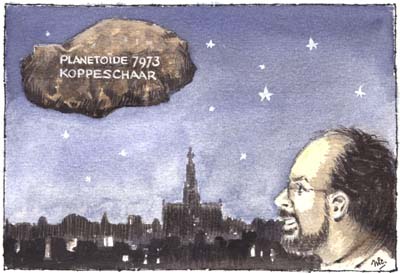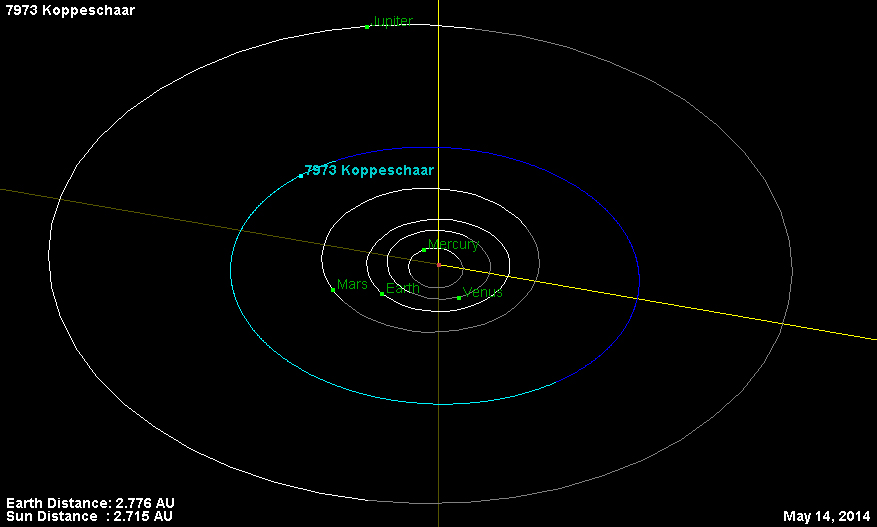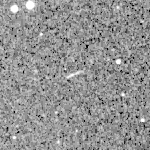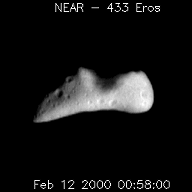
Illustration: Nico van Dam

Illustration: Nico van Dam

Orbital simulation of (7973) Koppeschaar
(Courtesy: Alan B. Chamberlin and Ron Baalke)
Thanks to Ron Baalke, Near-Earth Object Webmaster at the Jet Propulsion Laboratory, I can now view orbital simulations of my own asteroid 7973 Koppeschaar.
This is what Ron Baalke wrote:
Subject: New Orbit Visualization Tool Online
A new Orbits section has been added to JPL's Near-Earth Object home page.
The highlight is a cool visualization tool. It is an interactive 3D orbit
viewer written in Java, and you can view the orbit of any asteroid or
comet. You can rotate the orbits around and zoom in, move around
the solar system and "play" the orbits backwards and forwards
like a movie. It resides right here:
http://neo.jpl.nasa.gov/orbits
You'll have to select an object of interest first, by
either entering the asteroid/comet's name (wildcards are allowed),
or making a selection from the table of Potentially Hazardous
Asteroids provided.
Ron Baalke
Fri, 24 Mar 2000
So have a look at the specific
orbit of 7973 Koppeschaar!
Februari 22, 2000
Today I was able to locate my own minor planet on SkyMorph's plates that are on the Internet. Thanks to SkyMorph curator Thomas McGlynn for pointing me to that great site!
This is an image of 7973 Koppeschaar that is on DSS plate xe490 dating back to February 4, 1951:

Dear Carl,
You might want to try the SkyMorph web site to look
for your asteroid in the NEAT archive and in the DSS and DSS2
plate surveys.
Look at:
Just enter the name (or number) of your asteroid in the
moving target selection form and you'll get back a list
of NEAT images, and DSS and DSS2 plates on which the asteroid
might be found.
On this returned list, you can check all of the images,
and I'd also check the triplets and SkyView comparison
boxes.
When I tried this your asteroid was in the field of three
NEAT triplets (sets of three images taken about 20 minutes apart)
and showed up as a little traffic light of red-green-blue in the first.
When you check the triplets box
the SkyMorph page adds together the three elements of the triplet
so that static objects sum to white but moving objects have this
characteristic appearance.
I didn't see much indication of the asteroid in the later triplets.
There is a very clear detection on the DSS plate xe490 which has an
epoch of 1951 -- it might be usable in improving the orbit if it's
not already used in the solution. There are fainter trails in
the DSS2 images, but the asteroid is predicted to be more than a
magnitude fainter at those epochs.
The SkyMorph site is very slow. Expect to wait 10 minutes before
you get a response (it takes a long time to compute the ephemerides)
But I hope it is useful to you.
Congratulations,
Tom McGlynn
http://skys.gsfc.nasa.gov/skymorph/skymorph.html
and more particularly the moving target form:
http://skys.gsfc.nasa.gov/skymorph/mobs.html
NASA/GSFC/USRA
February 1, 2000
I am still a bit overwhelmed. Yesterday I received an e-mail from American astronomer Dr. Tom Gehrels who stated: "PS, it just came out that a poor asteroid is tootling around with the name Koppeschaar."
Would Tom have named an asteroid after me? I didn't dare to hope. Although there are about ten thousand asteroids with a known orbit, namegiving to a mortal is an exception. Of my fellow countrymen Rembrandt, Van Gogh, Vondel and Anne Frank were honored with an asteroid. Some other well known names: the Beatles, Marlene Dietrich, Audrey Hepburn, Alfred Hitchkok, Georg Gershwin, Conan Doyle, Jules Verne, Isaac Asimov, Jacques Cousteau and Donald Duck cartoonist Carl Barks.
Later on in the evening I got the confirmation by the International Astronomical Union's Minor Planet Center. Asteroid (7973) 1344-T2 is now known by the name "Koppeschaar".
7973 Koppeschaar has an orbital period of 4.86 years. It orbits the Sun at a mean distance of 429 million kilometers. It is a steady "mainbelter" between the orbits of Mars and Jupiter. According to Gehrels its diameter is about 6 kilometers. Its surface area is therefore 113 square kilometers. Apparently, I may call myself a landlord now!
Carl Koppeschaar
MPC 38197
Jan. 24, 2000
Carl Egon Koppeschaar is a science writer and reporter in the
Netherlands. He is internationally known for popularizing astrophysics
and space science, for debunking pseudoscience, and for taking
action against light pollution. His Moon Handbook: a 21st-Century
Travel Guide is a delight.(7973) Koppeschaar = 1344 T-2
Discovered 1973 Sept. 29 by C.J. van Houten and I. van
Houten-Groeneveld on Palomar Schmidt plates taken by T. Gehrels.
 |
Who can make the first photograph of 7933 Koppeschaar for Astronet?
Epoch 19990810:a = 2.8698463 AU (semimajor axis) q = 2.62888082 AU (perihelion distance) e = 0.0839641 (excentricity) i = 2.32417° (inclination W = 137.86069° (ascending node) w = 316.65021° (argument of perihelion) M = 34.8750826° (mean anomaly) T = February 18.972, 1999 (latest perihelion passage) Latest opposition: March 26.6, 2000
P = 4.86 y (orbital period)
The absolute magnitude H (at unit solar and terrestrial distance of 1 AU and the direction of opposition) and the albedo give us an indication of 7973 Koppeschaar's diameter:
H = 14.4 (absolute magnitude) D = 6 km (diameter at typical albedo of 0.15)
Future visitors may find the following data usefull for travelling to and/or approaching 7973 Koppeschaar:
v = 17,582 km/s (mean orbital velocity) t = 1.346 y (mean travel time from and to Earth using a Hohmann orbit)
All visitors should be aware of 7973 Koppeschaar's extreme low gravity:
g = 3 x 10^-9 m/s^2 (gravitational attraction) v(e) = 4 x 10^-3 m/s (escape velocity)
A person with a body weight of 100 kg on Earth will feel lighter than a feather, weighing only 0.03 milligrams. Visit 7973 Koppeschaar to get rid of your obesity problems!
Archimedes Institute
Class D Claim
Name of Claimant: Carl Egon Koppeschaar
Corporate or Other Affiliation: science journalist
Date: July 29, 2002
Class of Property Claim: D
Level of Control:
Mineral Resource Claim and Complete Control
Basis for Making Claim:
Mineral resources, mining rights, exploration and scientific research, tourism, energy harvesting, photography rights, government.
Precise Description of Claim:
#7973 Koppeschaar, a main-belt asteroid about 6 kilometers across, its potential satellites and the territorial space of 100,000 kilometers around its core, including all matter and energy therein that is existing on or beneath the surface or that will be produced in or purchased from that location.
Purpose of Claim and Development Schedule:
The purpose of this claim is to establish full ownership and exploitation rights of the celestial body that was named after the applicant by the International Astronomical Union (MPC 38197 of Jan. 24, 2000). This claim is in response to individuals and companies who sell real estate on the Moon and other celestial bodies, claiming ownership for their own profit. The ownership of asteroid 7973 Koppeschaar will be restricted to the applicant and will be heritable to his legal decendants.
----
Class D Certificate
As of July 29, 2002, Carl Egon Kopeschaar, has made a class D claim in the form
of mineral resource claim and complete control for property having boundaries
described as follows:
#7973 Koppeschaar, a main-belt asteroid about 6 kilometers across, its potential satellites and the territorial space of 100,000 kilometers around its core, including all matter and energy therein that is existing on or beneath the surface or that will be produced in or purchased from that location.
Lawrence D. Roberts
Director
The Archimedes Institute
 Back to ASTRONET's home page
Back to ASTRONET's home page